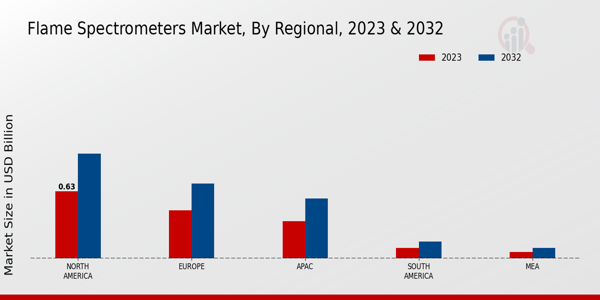Growth in the Pharmaceutical Sector
The pharmaceutical sector's expansion is a key driver for the Global Flame Spectrometers Market Industry. As the industry continues to grow, the need for precise analytical tools to ensure the quality and safety of pharmaceutical products becomes increasingly critical. Flame spectrometers are utilized for the analysis of metal content in drugs and formulations, ensuring compliance with regulatory standards. The rise in drug development activities and the increasing focus on quality assurance are likely to bolster the demand for flame spectrometers. This trend aligns with the overall market growth, which is expected to reach 3.05 USD Billion by 2035.
Rising Demand in Environmental Monitoring
The Global Flame Spectrometers Market Industry is experiencing heightened demand due to the increasing need for environmental monitoring. Governments worldwide are implementing stringent regulations to control pollution levels, which necessitates accurate and reliable analytical instruments. Flame spectrometers play a crucial role in detecting trace metals and pollutants in various matrices, including air, water, and soil. For instance, the United States Environmental Protection Agency emphasizes the importance of such technologies in ensuring compliance with environmental standards. This trend is expected to contribute to the market's growth, with projections indicating a market value of 1.76 USD Billion in 2024.
Increasing Adoption in Food Safety Testing
The Global Flame Spectrometers Market Industry is witnessing increased adoption in food safety testing, driven by rising consumer awareness regarding food quality and safety. Regulatory bodies are enforcing stringent safety standards, necessitating the use of reliable analytical methods to detect contaminants and ensure compliance. Flame spectrometers are effective in analyzing trace elements in food products, thus playing a vital role in quality assurance. For instance, the Food and Drug Administration in the United States mandates rigorous testing of food products for metal contaminants. This growing emphasis on food safety is expected to propel market growth in the coming years.
Emerging Markets and Industrial Applications
Emerging markets are becoming increasingly relevant to the Global Flame Spectrometers Market Industry, as industrial applications expand in regions such as Asia-Pacific and Latin America. The growth of manufacturing sectors in these regions drives the demand for flame spectrometers in quality control processes. Industries such as metallurgy, mining, and chemical manufacturing rely on flame spectrometry for accurate elemental analysis. As these markets develop, the need for advanced analytical instruments is likely to increase, contributing to the overall market growth. The Global Flame Spectrometers Market is expected to benefit from this trend, with a projected market value of 1.76 USD Billion in 2024.
Technological Advancements in Analytical Techniques
Technological advancements are significantly influencing the Global Flame Spectrometers Market Industry. Innovations in flame spectrometry, such as the development of more sensitive detectors and improved data processing algorithms, enhance the accuracy and efficiency of analyses. These advancements enable laboratories to conduct more complex analyses, thereby expanding the application range of flame spectrometers. For example, the integration of automation and artificial intelligence in analytical processes is streamlining workflows and reducing human error. As a result, the market is poised for growth, with a projected compound annual growth rate of 5.13% from 2025 to 2035.






















